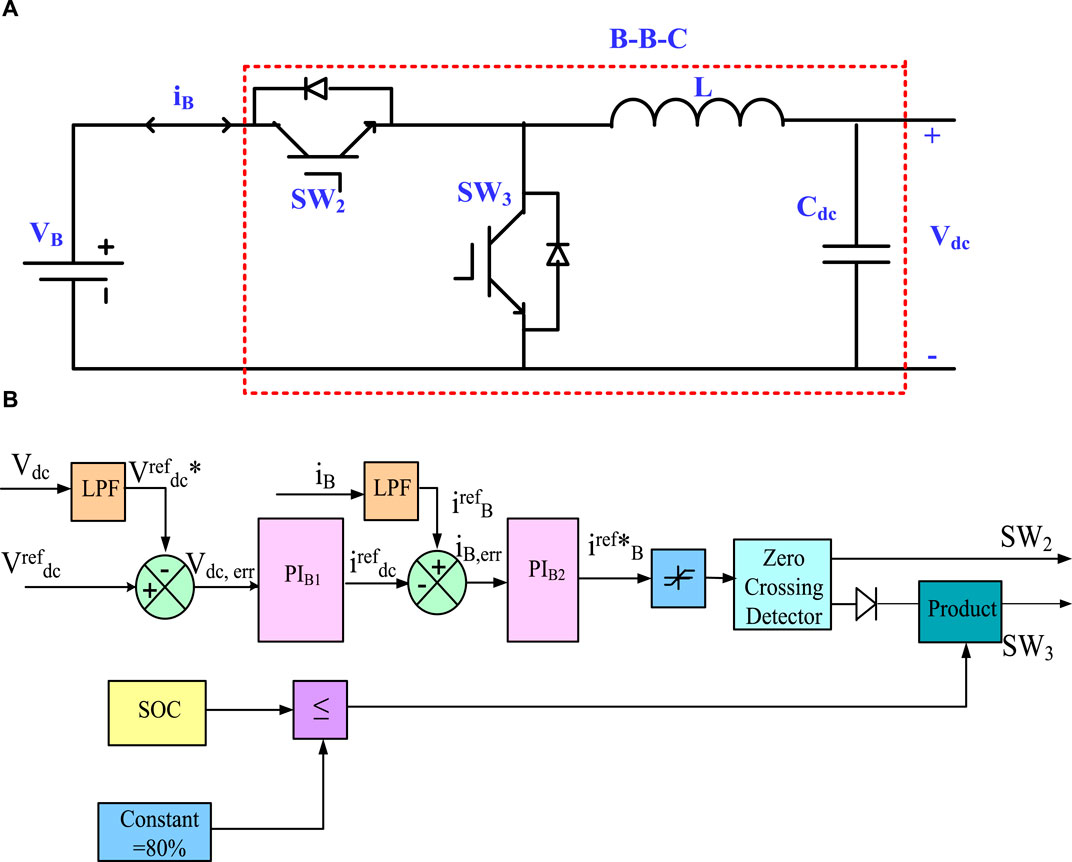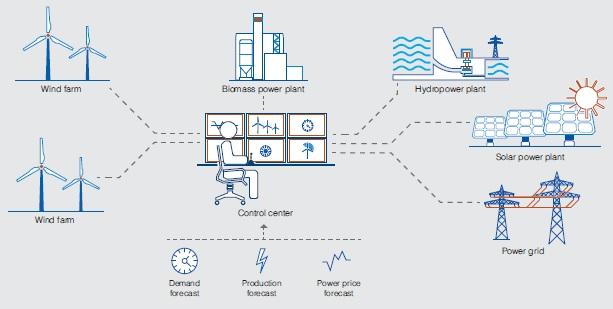Report on Smart Control and Management of a Stand-Alone Hybrid Renewable Energy System
Executive Summary
This report details an investigation into the smart management and control of an independent hybrid renewable energy system. The study presents a novel approach to enhance energy efficiency and reliability, directly contributing to several United Nations Sustainable Development Goals (SDGs). The system, comprising photovoltaic (PV), wind, and battery storage components, is designed to power remote regions, addressing the critical need for sustainable infrastructure. By integrating advanced control technologies, this research demonstrates a viable pathway to achieving SDG 7 (Affordable and Clean Energy), promoting SDG 13 (Climate Action) by reducing reliance on fossil fuels, and supporting SDG 11 (Sustainable Cities and Communities) by empowering isolated areas. The inclusion of a water pump load also highlights potential contributions to SDG 6 (Clean Water and Sanitation) and SDG 2 (Zero Hunger) through agricultural applications.
1. Introduction: Aligning with Sustainable Development Goals
The global transition towards renewable energy is a cornerstone of the 2030 Agenda for Sustainable Development. The depletion of fossil fuels and their detrimental environmental impact necessitate innovative solutions for clean energy generation. This research is motivated by the need to develop resilient and sustainable energy infrastructure, particularly for remote and off-grid communities, which is central to achieving universal energy access as outlined in SDG 7. Stand-alone hybrid systems, utilizing locally available solar and wind resources, offer a powerful tool for climate change mitigation (SDG 13) and for building resilient communities (SDG 11).
1.1. Research Contributions to SDGs
This study makes several key contributions toward advancing the SDGs:
- Advancing SDG 7 and SDG 13: By designing a system that relies exclusively on clean energy sources (solar and wind), this work directly supports the increase of the renewable energy share (Target 7.2) and combats climate change by eliminating greenhouse gas emissions from power generation.
- Fostering Innovation for SDG 9: The development and application of novel control techniques, such as the Adaptive Neuro-Fuzzy Inference System (ANFIS), represent a significant technological innovation for creating efficient and resilient infrastructure (Target 9.1).
- Supporting SDG 6 and SDG 11: The system is designed for practical application in isolated regions, enhancing their sustainability. The intelligent management of loads, including a water pump, demonstrates a direct application for improving water access (SDG 6) and supporting rural livelihoods.
2. System Description and Sustainable Design
The proposed stand-alone hybrid system is engineered for maximum efficiency and sustainability, integrating multiple components to ensure a reliable power supply.
2.1. System Components
- Photovoltaic System (PVS): Captures solar energy, a key pillar for achieving SDG 7.
- Wind Energy Conversion System (WECS): Harnesses wind power, diversifying the clean energy mix.
- Battery Storage System (BSS): Ensures energy availability and grid stability, which is crucial for reliable energy access (Target 7.1), by storing excess energy for use during periods of low generation.
- Power Electronics and Control Units: These devices manage energy flow efficiently, maximizing the utilization of renewable resources.
- System Loads: The system is designed to power AC loads, DC loads, and a water pump, demonstrating its versatility for community and agricultural needs, thereby linking to SDG 6.
3. Advanced Control Strategies for Enhanced Sustainability
To overcome the intermittency of renewable sources, this study implements intelligent control strategies. These innovations are critical for making renewable energy systems practical and reliable, a key requirement of SDG 9 (Industry, Innovation, and Infrastructure).
3.1. ANFIS-Based Maximum Power Point Tracking (MPPT)
An ANFIS-based MPPT technique was developed to optimize power extraction from both the PVS and WECS. This intelligent approach significantly enhances system efficiency compared to traditional methods like Perturb and Observe (P&O), ensuring that the maximum possible energy is harvested from available natural resources. This efficiency gain is vital for the economic viability and effectiveness of clean energy projects under SDG 7.
3.2. Voltage Stabilization and Storage System Control
An ANFIS-PI controller was implemented to manage the bidirectional converter of the battery storage system. This ensures a stable DC bus voltage, improving power quality and system reliability. Effective energy storage management is fundamental to integrating variable renewables and achieving the goals of SDG 7.
4. Intelligent Energy Management Framework
A supervisory control unit based on fuzzy logic was designed to manage power flow between the energy sources, storage system, and various loads. This framework ensures that energy is used efficiently and that critical loads are always supplied, contributing to the resilience required by SDG 11.
4.1. Load Prioritization Strategy
The management system prioritizes loads based on energy availability and the battery’s state of charge (SOC). This intelligent approach ensures that essential services are maintained while surplus energy is directed to lower-priority tasks, such as water pumping. This strategy not only optimizes energy use but also creates added value by supporting activities related to SDG 6 (water management) and SDG 2 (food production).
The management logic operates under various scenarios, from full power generation where all loads are active, to low-generation scenarios where only essential loads are powered, with the battery system balancing supply and demand.
5. Simulation Results and Discussion
The proposed system was simulated in the MATLAB/Simulink environment to validate its performance. The results confirm the superiority of the proposed control strategies and their positive impact on achieving sustainability objectives.
5.1. Performance of MPPT Controllers
The ANFIS-based MPPT controller demonstrated superior performance over conventional P&O, FLC, and PSO algorithms. Key improvements include:
- Higher Efficiency: The proposed technique achieved a production efficiency of 99.75% for the PVS and 98% for the WECS.
- Faster Response Time: The system responded rapidly to changes in weather conditions, minimizing energy loss.
- Reduced Oscillation: The controller maintained stable operation at the maximum power point, enhancing overall energy yield.
These results underscore the system’s capacity to deliver more reliable and affordable clean energy (SDG 7).
5.2. DC Bus Stability and Power Quality
The ANFIS-PI controller for the bidirectional converter successfully maintained a stable DC bus voltage with minimal overshoot and oscillation compared to traditional PI and Fuzzy-PI controllers. This stability is crucial for powering sensitive electronic equipment and ensuring the overall quality and reliability of the energy supply, a key aspect of sustainable infrastructure under SDG 9.
5.3. Effectiveness of Energy Management
The fuzzy logic-based energy management system effectively balanced power generation and consumption across various simulated weather conditions. The system successfully prioritized loads, ensured the battery operated within safe limits, and utilized surplus energy for water pumping. This demonstrates a practical and intelligent approach to resource management that directly supports the integrated nature of the SDGs, linking energy (SDG 7) with water (SDG 6) and community resilience (SDG 11).
6. Conclusion and Future Outlook
This report has presented a smart control and management system for a stand-alone hybrid renewable energy system that demonstrates significant improvements in efficiency, stability, and intelligent load management. The proposed ANFIS-based controllers and fuzzy logic energy management framework provide a robust solution for deploying clean energy in remote areas.
The findings strongly support the feasibility of using such advanced systems to meet multiple Sustainable Development Goals. The work contributes directly to:
- SDG 7: By providing a blueprint for efficient, reliable, and affordable clean energy systems.
- SDG 13: By offering a fossil fuel-free energy solution.
- SDG 9: Through the development of innovative control technologies for resilient infrastructure.
- SDG 11, SDG 6, and SDG 2: By empowering remote communities with sustainable energy for essential services like water pumping for domestic use and agriculture.
Future work can expand on this model by incorporating other renewable sources, diversifying storage technologies, and applying the system to other critical needs such as electric vehicle charging stations in remote locations. These efforts will continue to advance the global transition to a sustainable and equitable energy future.
Analysis of Sustainable Development Goals (SDGs) in the Article
1. Which SDGs are addressed or connected to the issues highlighted in the article?
The article on smart control and management of a renewable energy-based stand-alone hybrid system addresses several Sustainable Development Goals (SDGs) through its focus on technology, energy access, environmental impact, and resource management.
- SDG 6: Clean Water and Sanitation: The system is designed to power various loads, including a “water pump” specifically for “agricultural applications.” By providing a reliable energy source for water pumping, the technology contributes to water management, which is a key aspect of SDG 6.
- SDG 7: Affordable and Clean Energy: This is the most central SDG to the article. The entire study is about developing an efficient and reliable system based on renewable energy sources (solar and wind). It aims to provide power to “remote regions,” “isolated areas,” and “rural areas away from electrical grids,” directly tackling the goal of universal access to clean and modern energy.
- SDG 9: Industry, Innovation, and Infrastructure: The paper is fundamentally about technological innovation. It proposes and develops new control techniques (ANFIS-based MPPT, ANFIS-PI) to improve the efficiency and reliability of energy infrastructure. This development of “resilient infrastructure” for remote areas is a core component of SDG 9.
- SDG 13: Climate Action: The article’s introduction explicitly frames the need for renewable energy as a response to the negative environmental impacts of fossil fuels, such as their effect on the “ozone layer expansion and environmental pollution.” One of the stated contributions is that “green hybrid systems has the potential to make a significant contribution towards environmental preservation by mitigating the release of damaging gas emissions,” which is a direct climate action measure.
2. What specific targets under those SDGs can be identified based on the article’s content?
Based on the article’s content, the following specific SDG targets can be identified:
-
Target 6.4: By 2030, substantially increase water-use efficiency across all sectors and ensure sustainable withdrawals and supply of freshwater.
- Explanation: The article mentions that the system can power a “water pump” and that this load can be managed intelligently to “make full use of the energy produced.” This application in agriculture directly supports more efficient water management by providing a controlled power source for irrigation, contributing to increased water-use efficiency.
-
Target 7.1: By 2030, ensure universal access to affordable, reliable and modern energy services.
- Explanation: The study explicitly states that the “proposed study holds great potential for remote regions” and can be used to support “isolated areas such as military barracks, islands, and even rural areas away from electrical grids.” This directly aligns with the goal of extending energy access to underserved populations.
-
Target 7.2: By 2030, increase substantially the share of renewable energy in the global energy mix.
- Explanation: The system described is an “independent hybrid system based on renewable energies,” utilizing a “photovoltaic system (PVS)” and a “wind energy conversion system (WECS).” The entire premise of the research is to make such 100% renewable systems more viable and efficient, thereby contributing to increasing the share of renewables.
-
Target 7.3: By 2030, double the global rate of improvement in energy efficiency.
- Explanation: A primary focus of the paper is to “enhance the efficiency of the generated energy.” It proposes an “ANFIS-based MPPT technique” to “enhance the efficiency of the PVS and WECS” and compares its performance to other methods, demonstrating a production effectiveness of “99.75% for PVS and 98% for WECS.” This directly addresses the goal of improving energy efficiency.
-
Target 9.4: By 2030, upgrade infrastructure and retrofit industries to make them sustainable, with increased resource-use efficiency and greater adoption of clean and environmentally sound technologies.
- Explanation: The paper is a clear example of developing and promoting “clean and environmentally sound technologies.” The use of advanced control systems like ANFIS to optimize solar and wind power generation represents an upgrade to energy infrastructure to make it more sustainable and efficient.
3. Are there any indicators mentioned or implied in the article that can be used to measure progress towards the identified targets?
The article mentions or implies several indicators that can be used to measure progress towards the identified targets:
- Indicator for Target 7.1 (Implied): The article’s focus on providing energy to “remote regions” and “rural areas away from electrical grids” implies progress towards Indicator 7.1.1: Proportion of population with access to electricity. The deployment of such systems would directly increase this proportion in targeted areas.
- Indicator for Target 7.2 (Mentioned): The system is composed entirely of solar and wind energy sources. This directly relates to Indicator 7.2.1: Renewable energy share in the total final energy consumption. For the standalone system described, this share is 100%.
- Indicator for Target 7.3 (Mentioned): The article provides specific metrics for efficiency improvements. It states the proposed technique achieved a “production effectiveness of 99.75% for PVS and 98% for WECS.” This serves as a direct measure of energy efficiency improvement, which is the concept behind Indicator 7.3.1: Energy intensity measured in terms of primary energy and GDP, although measured here at a system level.
- Indicator for Target 9.4 (Implied): The article states a key contribution is “mitigating the release of damaging gas emissions” by using green energy instead of fossil fuels. This implies a reduction in CO2 emissions, which is measured by Indicator 9.4.1: CO2 emission per unit of value added. The proposed system would have zero operational emissions, demonstrating progress on this indicator.
4. Table of SDGs, Targets, and Indicators
| SDGs | Targets | Indicators |
|---|---|---|
| SDG 6: Clean Water and Sanitation | 6.4: Substantially increase water-use efficiency across all sectors. | Implied: Use of a smart-controlled water pump for agricultural applications to optimize water and energy use, contributing to Indicator 6.4.1 (Change in water-use efficiency over time). |
| SDG 7: Affordable and Clean Energy | 7.1: Ensure universal access to affordable, reliable and modern energy services. | Implied: The system is designed for “remote regions” and “rural areas,” which would increase the value of Indicator 7.1.1 (Proportion of population with access to electricity). |
| 7.2: Increase substantially the share of renewable energy in the global energy mix. | Mentioned: The system is based entirely on photovoltaic and wind energy, directly contributing to Indicator 7.2.1 (Renewable energy share in the total final energy consumption). | |
| 7.3: Double the global rate of improvement in energy efficiency. | Mentioned: The proposed MPPT technique achieves a production effectiveness of 99.75% for PVS and 98% for WECS, demonstrating a direct improvement in energy efficiency (related to Indicator 7.3.1). | |
| SDG 9: Industry, Innovation and Infrastructure | 9.4: Upgrade infrastructure and adopt clean and environmentally sound technologies. | Implied: The development of an advanced, efficient renewable energy system contributes to reducing emissions, which is measured by Indicator 9.4.1 (CO2 emission per unit of value added). |
| SDG 13: Climate Action | 13.2: Integrate climate change measures into national policies, strategies and planning. | Mentioned: The article highlights that the system helps in “mitigating the release of damaging gas emissions,” a key climate action measure. |
Source: nature.com







